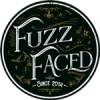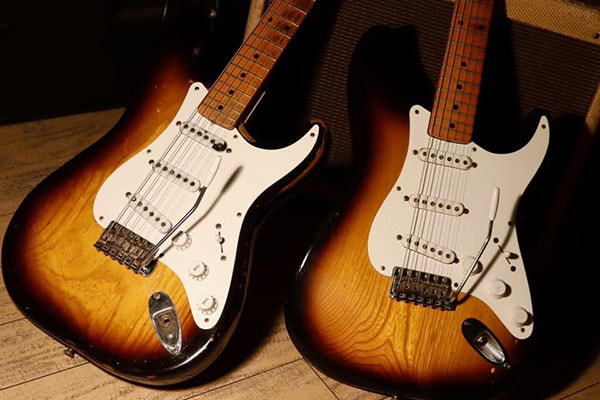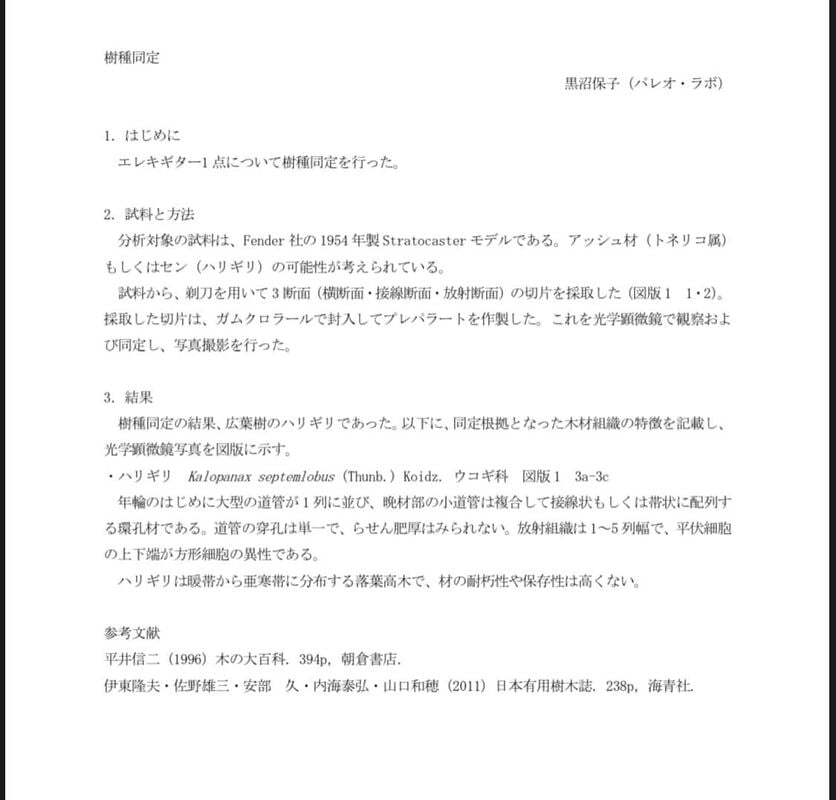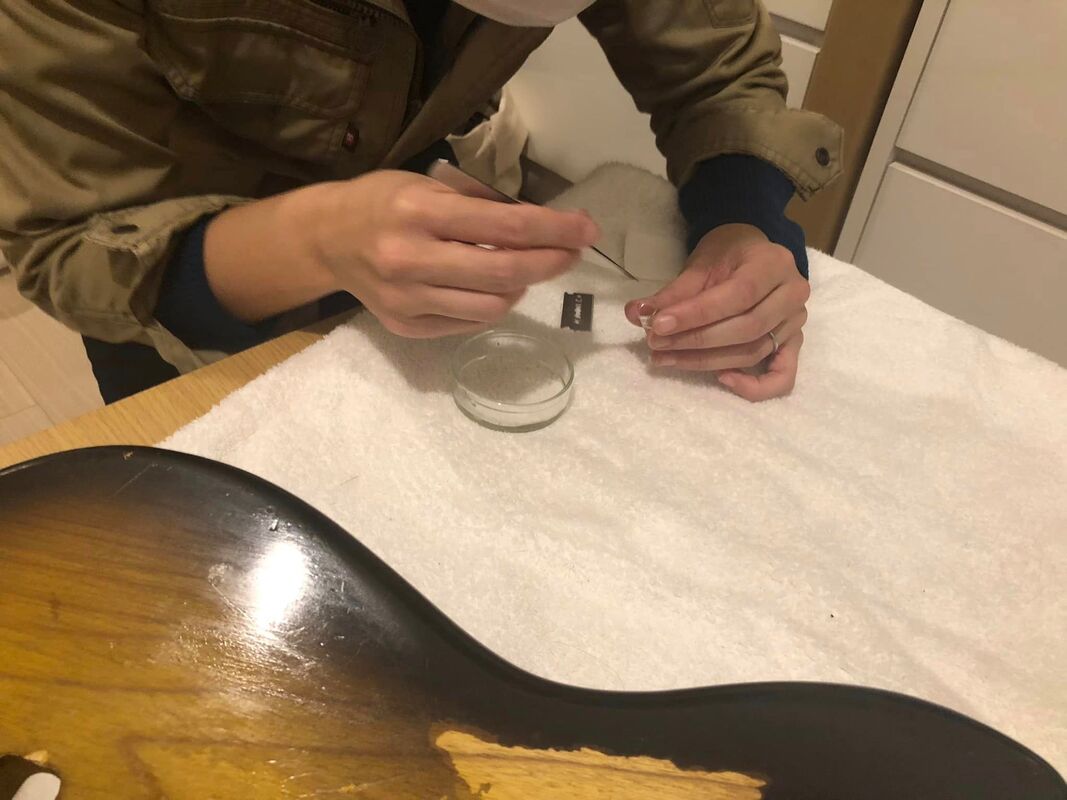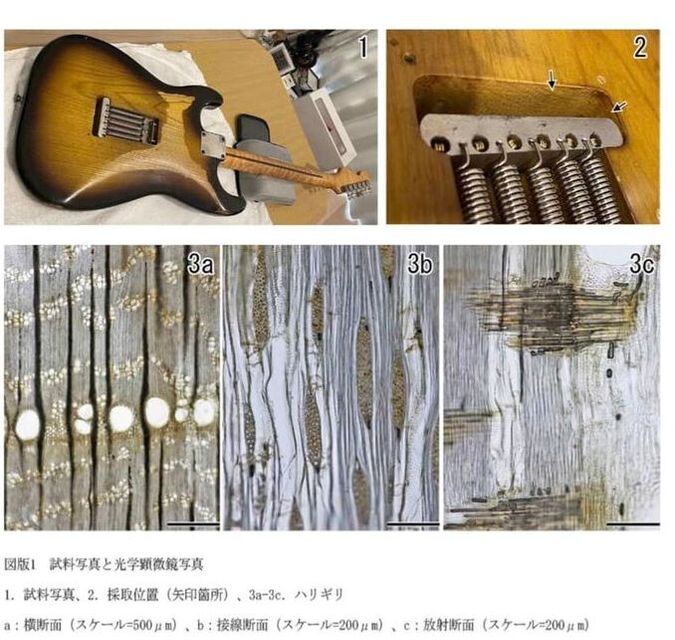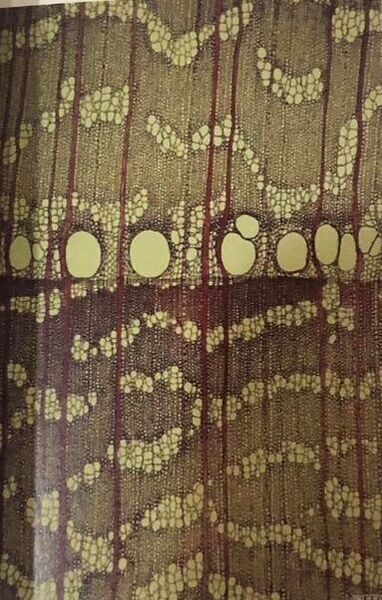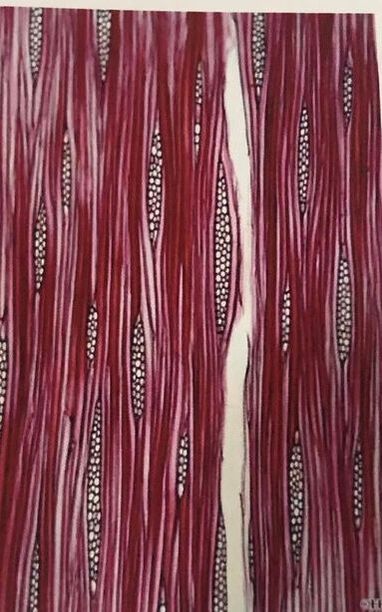SOMETHING NEW ABOUT 1954 FENDER STRATOCASTER
Contrary to popular belief, the first Stratocasters, dated 1954, did not all feature an ash body, but many had a Sen Ash body. Confirmation of this has come from Urufa Kina, a young Japanese guitarist and composer who conducted analyses on his 1954 Fender Stratocaster with serial number 1038.
The wood identification test, aimed at determining the wood used for the body, was conducted by Paleo Labo Co., a company affiliated with the Japanese Archaeological Association.
The wood identification test, aimed at determining the wood used for the body, was conducted by Paleo Labo Co., a company affiliated with the Japanese Archaeological Association.
|
The conclusion drawn was Kalopanax Septemlobus (a.k.a. Acanthopanax Ricinifolius). Guitarists often refer to this timber as Sen Ash because of its similar grain. However, strictly speaking, Kalopanax Septemlobus is a different species from ash, as it belongs to the Araliaceae family, while ash belongs to the Fraxinus family. Thus, Sen and Ash belong to completely different species.
Sen gained recognition among Fender enthusiasts as it was used for the bodies of some Japanese JV Stratocasters. According to Urufa Kina, the ‘54 Strat sen body seems more lightweight than the ash one and has tighter and more lustrous wood grain. He also believes that half of the 1954 strats on the market seem to have Sen body, so it is not so rare. |
Kalopanax Septemlobus is native to northeastern Asia, ranging from Sakhalin and Japan west to southwestern China. The reason why Leo Fender chose to use this exotic timber is not known. There are two theories about its origin. Firstly, Sen was the wood most commonly exported by Japan after the war. Secondly, Sen was an invading species that spread in the USA.
Here is the English translation of the report.
Here is the English translation of the report.
TREE SPECIES IDENTIFICATION - PALEO LABO CO. - LTD.
|
INTRODUCTION
An analysis for wood species identification was carried out on an electric guitar. SAMPLES AND METHODS The analyzed sample was taken from a 1954 Fender Stratocaster model. The wood species of Ash (Fraxinus) or Sen (Kalopanax Septemlobus) was considered. Three sections—transverse, tangential, and radial—were obtained from the sample using a razor blade (1.3a-1.3c). These sections were embedded in gum Arabic, prepared as microscope slides, and examined under an optical microscope. Photographs were taken for documentation. |
RESULTS
The wood species identification revealed that the sample belonged to a broad-leaved tree species known as Kalopanax Septemlobus. Below are the identifying features of the wood tissue, accompanied by optical microscope images.
The wood species identification revealed that the sample belonged to a broad-leaved tree species known as Kalopanax Septemlobus. Below are the identifying features of the wood tissue, accompanied by optical microscope images.
In the earlywood, large vessels of each grow ring are arranged in one row. The parenchyma cells in the latewood exhibit a complex tangential or band-like arrangement, characteristic of ring-porous wood.
Rays are uniseriate, and spiral thickenings are not observed. The radial tissue consists of 1 to 5 rows, with square-shaped procumbent cells at the upper and lower ends.
Kalopanax septemlobus is a deciduous tall tree found in submontane to montane forests, distributed across temperate to subarctic zones. The wood exhibits low resistance to decay and preservation.
Rays are uniseriate, and spiral thickenings are not observed. The radial tissue consists of 1 to 5 rows, with square-shaped procumbent cells at the upper and lower ends.
Kalopanax septemlobus is a deciduous tall tree found in submontane to montane forests, distributed across temperate to subarctic zones. The wood exhibits low resistance to decay and preservation.
References:
- Shinji Hirai (1996) Wood Encyclopedia. 394p, Asakura Shoten.
- Takao Ito, Yuzo Sano, Hisashi Abe, Yasuhiro Utsumi, and Kazuho Yamaguchi (2011) Useful Trees of Japan. 238p, Kaishosei.
- Yasuko Kuronuma (Paleo Lab)
- Shinji Hirai (1996) Wood Encyclopedia. 394p, Asakura Shoten.
- Takao Ito, Yuzo Sano, Hisashi Abe, Yasuhiro Utsumi, and Kazuho Yamaguchi (2011) Useful Trees of Japan. 238p, Kaishosei.
- Yasuko Kuronuma (Paleo Lab)
SASSAFRAS AND SPRUCE
There is a widespread belief that some 1954 Stratocasters had bodies made of sassafras or spruce.
Sometimes one tends to believe in stories like that, coming from eminent people.
For instance, Eric Johnson was convinced that his 1954 Stratocaster, nicknamed Virginia, had a Sassafras body based on the advice of a well-known former Master Builder who declared it to be Sassafras. Fender even produced a replica of this guitar with a sassafras body, which appeared to be a marketing tactic.
Unfortunately, they did not physically examine the original guitar; their affirmation was solely based on pictures. They should have had the real Virginia and proved it. But they couldn’t do so.
As a result, a legend was born, and guitarists often confuse quartersawn ash with sassafras. Moreover, some guitarists claimed that certain '54 Stratocaster bodies were made of spruce, but upon examination, all guitars believed to be spruce turned out to be ash.
Sometimes one tends to believe in stories like that, coming from eminent people.
For instance, Eric Johnson was convinced that his 1954 Stratocaster, nicknamed Virginia, had a Sassafras body based on the advice of a well-known former Master Builder who declared it to be Sassafras. Fender even produced a replica of this guitar with a sassafras body, which appeared to be a marketing tactic.
Unfortunately, they did not physically examine the original guitar; their affirmation was solely based on pictures. They should have had the real Virginia and proved it. But they couldn’t do so.
As a result, a legend was born, and guitarists often confuse quartersawn ash with sassafras. Moreover, some guitarists claimed that certain '54 Stratocaster bodies were made of spruce, but upon examination, all guitars believed to be spruce turned out to be ash.
ABOUT URUFA KINA
|
Born in 1995, Guitarist and composer from Okinawa Japan. Proficient in a wide range of playing styles such as technical fusion, alternative, and funk rock.
Moved to Tokyo in 2017 and participated in numerous live shows, sessions, and recordings. On social media, he shares a fresh perspective on sound-making with the guitar, attracting attention from a diverse range of musicians regardless of genre. Instagram @urufa_1954 YouTube @urufa3499 |
